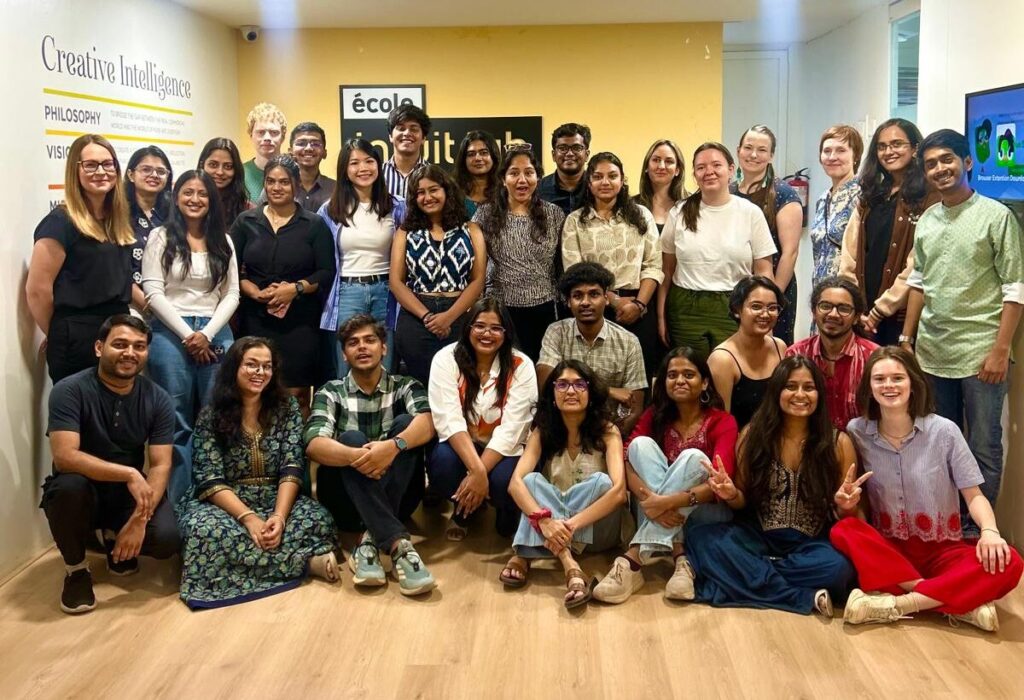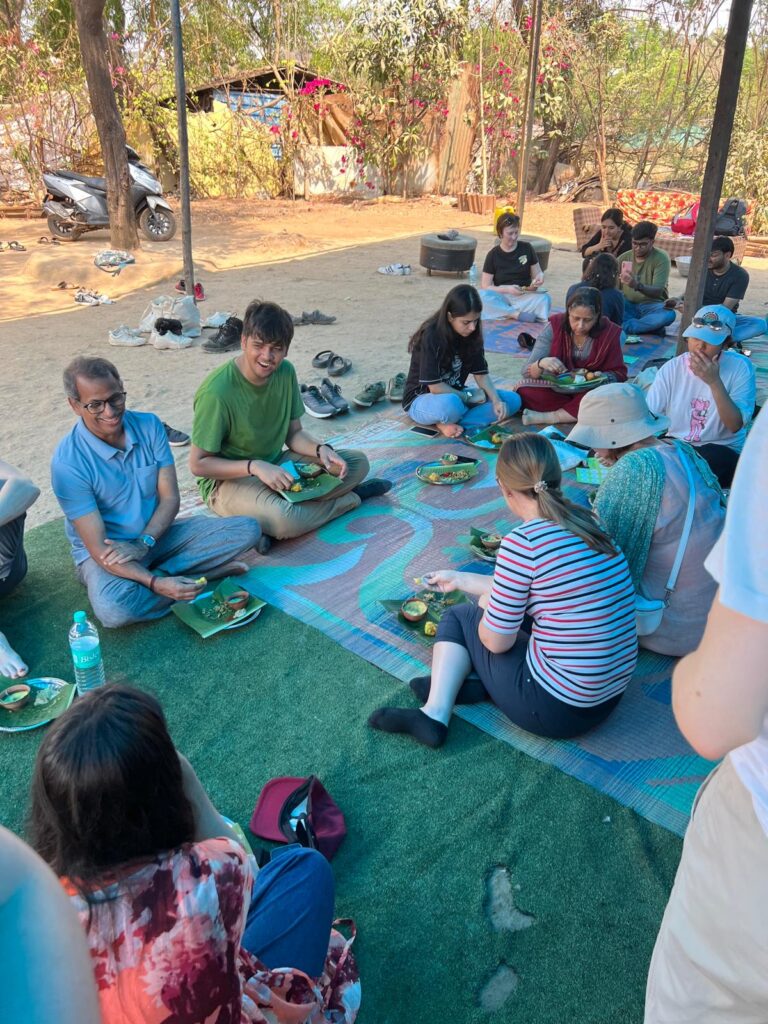As part of the Co-Life project, the Impact Focused Entrepreneurship (IFE) course was organized, bringing together a diverse group of students from India, Finland, Belgium, and Denmark. From Laurea University of Applied Sciences, three students—Tiina Mustonen, Matilda Pontán, and Katja Lajunen—from the Future-Oriented Project Management program participated, alongside IFE course lecturers Tiina Lehtosaari and Salla Kuuluvainen. The course began in January 2025 with preparatory online lectures and team formations. At the same time, each team’s future project partner company was introduced, along with guidelines for the development project.

Image 1: Students at École Intuit Lab design school in Mumbai. Photo: Sanskriti Shukla
The actual project work began in late January 2025 at the Goa Institute of Management (GIM) with a week of in-person learning where course participants met face to face. The intensive week was filled with lectures, workshops, and co-creation. This time spent together in person was important for team-building. The closed campus of GIM proved ideal for fostering a strong team spirit. Living on campus and spending evenings together supported building connections. During the in-person week, project roadmaps were created and decisions made regarding operating models, co-creation platforms, and communication channels. Responsibilities within the multidisciplinary teams were divided based on individual strengths and whether the students were located in Finland or India. The Indian students stayed in contact with the local partner companies and conducted interviews with Indian stakeholders. Meanwhile, the Finnish students focused on research and project management.
Online Project Work and Co-Creation
Project work continued online with guidance and coaching from instructors. Virtual teams require specific tools for effective co-creation. Tools like Miro were successfully used for project management and brainstorming sessions. Students were able to apply previously learned concepts from the Future-Oriented Project Management course, such as design thinking and service design, to solve challenges. These methodologies, along with the Double Diamond model, were not familiar to the Indian students, making the contributions from the Finnish students particularly valuable.
“We found that real-time, facilitated collaboration in Miro was the most effective way to advance our work. While team members worked diligently on their individual tasks, we could have used more time for joint innovation and knowledge sharing. Scheduling issues made it feel at times like knowledge remained siloed, and we didn’t always have a shared understanding of the project status,” says Katja Lajunen.
Remote Leadership and Virtual Teams
Remote leadership played a major role in the Co-Life project during the online work phase between the on-site sessions in Goa and Mumbai. Key aspects of remote leadership included clear communication, encouragement, and task distribution in a setting where team members were in different countries, time zones, and cultural contexts. Collaboration required patience and continuous dialogue. Time differences between Finland and India and the students’ varied academic schedules posed challenges for arranging meetings. Even in a motivated team, maintaining a shared picture of the project was difficult. Not all information was always evenly distributed.
“Remote project work gave us a concrete learning experience of collaborating in a geographically and culturally diverse team,” says Matilda Pontán. “It requires planning, transparency, and human-centered leadership—but above all, genuine interest in team members and their perspectives,” she adds.
According to Pontán, Mustonen, and Lajunen, communication in remote work needs to be deliberate and abundant: all relevant information should be documented, shared openly, and regularly updated for the entire team. Without non-verbal cues, misunderstandings can go unnoticed. Teams should also reflect together on what communication methods are working, what challenges have arisen, and what could be improved to enhance collaboration.
Leading virtual teams requires both transformational and transactional leadership skills: it’s essential to set clear expectations and goals while also motivating and inspiring the team. A leader’s cultural awareness is key to successful team management in a global and diverse environment. (Mukherjee et al., 2012, pp. 277–279).
Trust and Psychological Safety in the Team
Cultural diversity adds complexity to virtual teamwork. With different nationalities and primarily virtual interaction, culturally sensitive and adaptive leadership is needed to support integration into the team and create a foundation for effective and positive communication (Gilson et al., 2015, p. 16). Getting to know each other personally helped move project tasks forward. This meant communicating with each team member individually and building mutual understanding piece by piece, whether the topic was a shared task or life circumstances hindering participation—illness, other coursework, or job searching.
“It was a big sign of trust that team members shared concerns about their personal lives and health and let us into their daily lives. That showed our team had bonded well, and the atmosphere was safe,” says Tiina Mustonen. “We used the waiting minutes before remote meetings to get to know each other. On a virtual house tour, I showed what Finnish homes look like and, in return, saw stunning outfits from a fashion show one of our teammates had modeled in,” Tiina adds.
During the final in-person week in Mumbai, project work continued during the day at École Intuit Lab. In the evenings, students dispersed to their hotels, leaving less time for socializing.
“On the other hand, we had already gotten to know each other well in Goa and through online meetings, so working in Mumbai flowed smoothly. During the second in-person week, friendships deepened, humor was shared, and we supported each other’s work,” Katja notes.
Coaching and Feedback
In this multicultural project, feedback was provided in various ways by instructors and was generally seen as helpful and forward-moving. In some cases, the tone or delivery of feedback caused confusion or uncertainty, and some groups felt unsure about the direction of their work. This highlighted the importance of culturally sensitive, understandable, and constructive feedback. The experiences pointed to a need for more dialogical and encouraging feedback practices.
Good feedback is concrete, timely, and balanced: it acknowledges successes and clearly indicates areas for improvement in a supportive and positive way. Feedback should always aim to support learning and growth. A coach must be highly skilled in interpersonal communication. Constructive, trust-building feedback also strengthens team dynamics. Research shows that impactful feedback not only tells what needs improvement but also clearly guides the next steps (Hattie & Timperley, 2007, p. 82). Open and respectful feedback dialogues also enhance shared learning and commitment to goals (Stone & Heen, 2014, p. 6).
Contrasts of Mumbai
Mumbai is a city of contrasts—loud, hectic, and vast, yet also green and vibrant. The streets are crowded with people, vehicles, and constant motion. The city’s layered nature is reflected in its architecture, culture, and pace—modern buildings alternate with older neighborhoods, and tradition lives side by side with international urban development. This diversity also manifests in disparities in living standards: in narrow alleys and densely packed residential areas, people live modestly amid strong community spirit and vitality.
In addition to intensive project work, the team visited the indigenous Worli tribe in the Aarey Forest, often called the lungs of Mumbai. There, they learned about local plants, natural dyes, Worli art, and dance, as presented by the tribe. The forest visit broadened their understanding of Mumbai’s diversity—even within a bustling metropolis lies a peaceful area with a nature-loving people. Another visit to the urban planning collective Urbz in the Dharavi neighborhood offered additional insight into Mumbai’s complexity. (More about that in our publication: Impact Entrepreneurship in India as part of Future-Oriented Project Management Studies).

Image 2: Co-Life students enjoying lunch with the Worli tribe in Aarey Forest. Photo: Tiina Mustonen
Ideas for Improvement
In the final feedback discussion, participants were asked whether they would join the course again, knowing the workload and time pressures. Everyone answered yes! The richness of the experience and learning outweighed the challenges and moments of exhaustion. Face-to-face collaboration was seen as the most fruitful and effective. Based on this, a suggestion arose to organize the course as an intensive, continuous in-person program in India. For the European students, the experience of a fascinating culture and new environment was also a major highlight.
At the end of the week, project outcomes were presented to the partner companies via online meetings. The virtual format limited the possibility of in-depth final discussions between the companies, project teams, and teachers. It was suggested that more in-depth introductions to the companies should occur at the beginning. Teams only visited their partner companies once briefly, and communication continued as needed via email. A more fruitful approach might include workshop-style sessions with companies at the beginning, midpoint, and end of the project to delve deeper into the topics and gather broader feedback.
International project work within sustainable development will become increasingly important in the future. We must be able to share perspectives and identify solutions to global challenges. Developing impact-focused entrepreneurship is a promising path toward this goal. The Co-Life project offered a fantastic opportunity to gain experience and tools for working life.